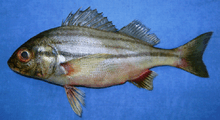Pomadasys stridens
Pomadasys stridens, the striped piggy or lined piggy, is a grunt from the western Indian Ocean, it is one of a group of Indo-Pacific marine species which have colonised the Mediterranean Sea through the Suez Canal from the Red Sea, a process known as Lessepsian migration.
| Pomadasys stridens | |
|---|---|
 | |
| Scientific classification | |
| Kingdom: | Animalia |
| Phylum: | Chordata |
| Class: | Actinopterygii |
| Order: | Perciformes |
| Family: | Haemulidae |
| Genus: | Pomadasys |
| Species: | P. stridens |
| Binomial name | |
| Pomadasys stridens (Forsskål, 1775) | |
| Synonyms[1] | |
| |
Description
Pomadasys stridens has a silvery body which is slightly darker dorsally than it is ventrally, it has 3-4 golden-brown stripes along its body, merging towards the caudal peduncle,[2] and a dark blotch on the operculum.[3] It has a relatively large head with a small, slightly oblique mouth and two pores on the tip of the chin which lie in front of a short indentation.[2] It has 12 spines and 13–14 soft rays in the dorsal fin with 3 spines and 3 soft rays in the anal fin.[3] It grows up to 23 cm[4] standard length but averages 10 cm,[2] with females normally growing to a slightly larger size than males.[5]
Distribution
Pomadasys stridens is indigenous to the western Indian Ocean from the Red Sea south along the eastern African coast to South Africa, east to the wester coast of India, including the Persian Gulf, Lakshadweep archipelago and the Maldives, it is also found off Madagascar and the Seychelles and Mascarene islands.[3][5] It was recorded for the first time in the Mediterranean in 1969 in the Gulf of Genoa, later being found in the Bardawil Lagoon in Sinai and then being reported in the Levantine Sea off the coasts of Israel and Lebanon. By 2011 it was established off İskenderun in Turkey with 335 being collected in 2011 and 2012, with the first record for the Aegean Sea in 2015, while this species was also recorded for the first time in waters off eastern Cyprus in 2014.[6][7]
Habitat
Pomadasys stridens is found in waters over sandy and muddy substrates down to a depth of 55m,[2] but has been associated with reefs[3] and with rocky tidal pools.[4]
Biology
Pomadasys stridens spawns between December and March in the Persian Gulf,[5] while in the Mediterranean it takes place during the summer,[2] and the fish form pairs during spawning.[3] It is a carnivorous species and the crustaceans, molluscs, small fish and polychaete worms make up the majority of its diet. It is a social species and fish in larger groups fed better than those in smaller groups[4]
Fisheries
Pomadasys stridens is not regarded as a food fish in South Africa where it may be caught as a bait fish but it is regarded as a commercially important food fish in the northern Indian Ocean in areas such as the Gulf of Aqaba, Persian Gulf and the Bitter Lakes in Egypt.[5][3]
References
- "Synonyms of Pomadasys stridens (Forsskål, 1775)". Fishbase.org. Retrieved 21 July 2017.
- J.C. Hureau. "Pomadasys stridens". Marine Species Identification Portal: Fishes of the NE Atlantic and Mediterranean. ETI Bioinformatics. Retrieved 21 July 2017.
- Pascualita Sa-a; Cristina V. Garilao (2017). R. Froese; D. Pauly (eds.). "Pomadasys stridens (Forsskål, 1775) Striped piggy". Fishbase.org. Retrieved 21 July 2017.
- Amtyaz Safi; M. Atiqullah Khan; M. Zaheer Khan; M. Usman Ali Hashmi (2013). "Observations on the Food and Feeding Habits of Striped piggy, Pomadasys stridens (Forsskal, 1775) (Family; Pomadasyidae) from Karachi Coast, Pakistan" (PDF). International Journal of Fauna and Biological Studies. 1 (1): 7–14.
- Sajjad karimi; Nasrollah Mahbobi Soofiani; Fatemeh Paykanheirati; Elham Katiraei (2014). "Reproductive Biology of Stripped Piggy (Pomadasys stridens Forsskal, 1775) in Northern Part of Persian Gulf (Bushehr) (English abstract)". JAIR (in Persian). 2 (3): 87–100.
- Okan Akyol; Vahdet Ünal (2016). "First record of a Lessepsian migrant, Pomadasys stridens (Actinopterygii: Perciformes: Haemulidae) from the Aegean Sea, Turkey". Acta Ichthyologica et Piscatoria. 46 (1): 53–55.
- Samuel P. Iglesias; Lou Frotté (2015). "Alien marine fishes in Cyprus: update and new records" (PDF). Aquatic Invasions. 10 (4): 425–438. doi:10.3391/ai.2015.10.4.06.